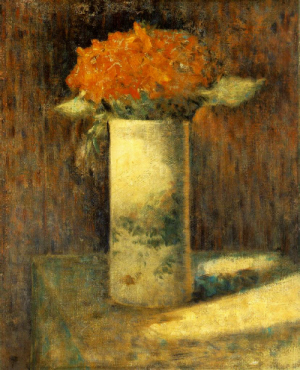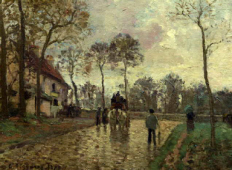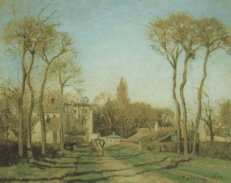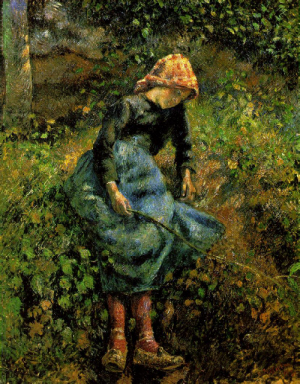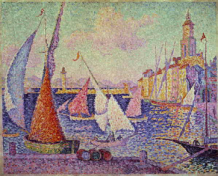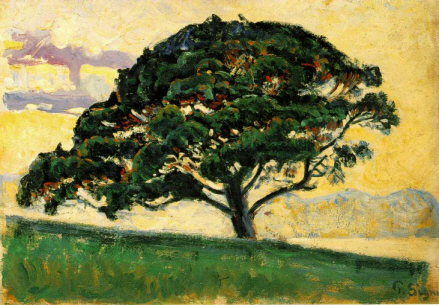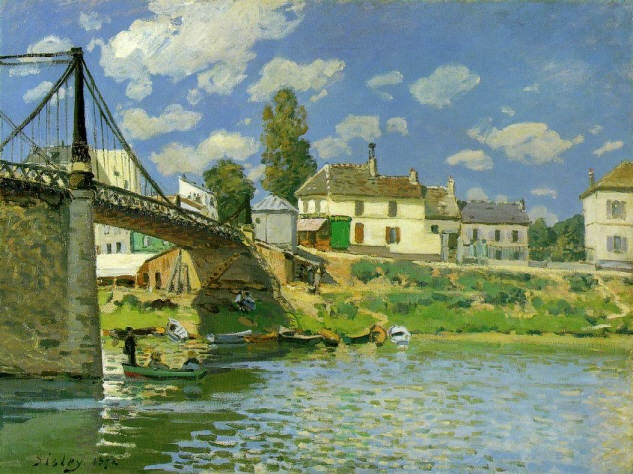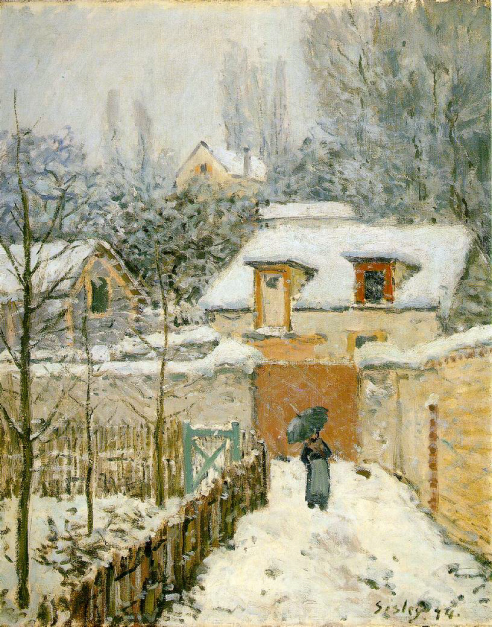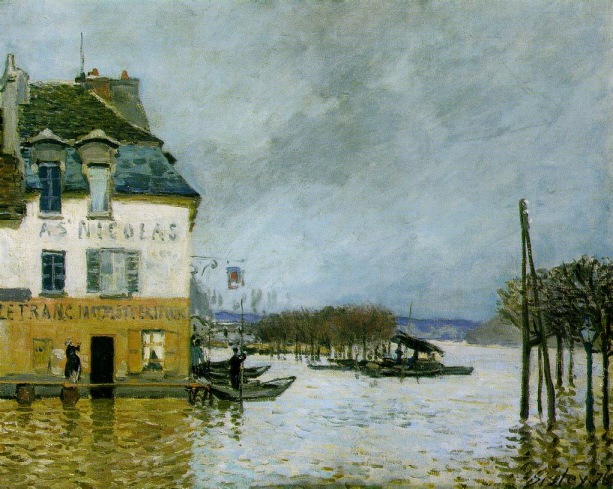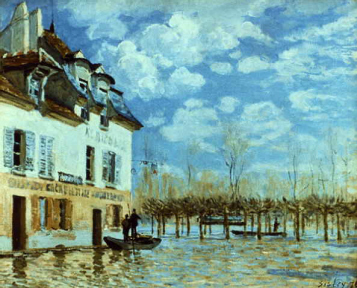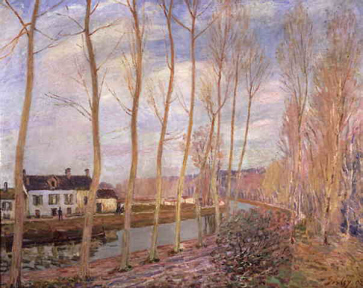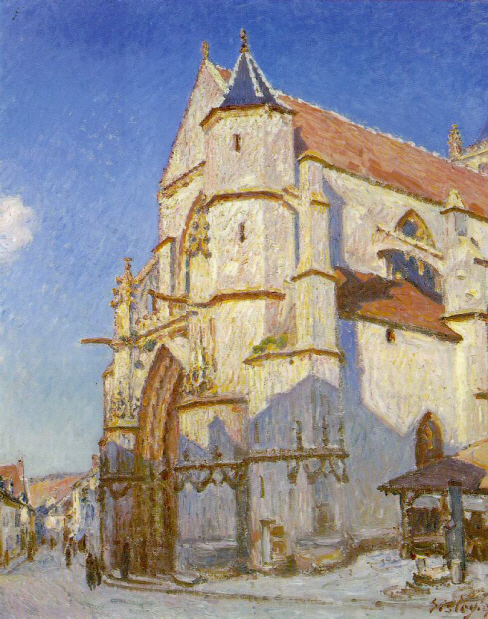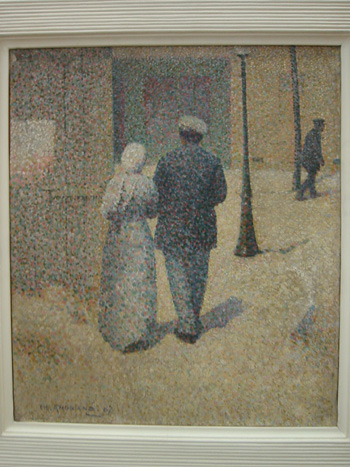
pointlism?
divinism?
작품과 액자가 얼마나 멋지게 맞아떨어지던지..
seurat georges
(b. Dec. 2, 1859, Paris--d. March 29, 1891, Paris)
Painter, founder of the 19th-century French school of Neo-Impressionism whose technique for portraying the play of light using tiny brushstrokes of contrasting colours became known as Pointillism. Using this techique, he created huge compositions with tiny, detached strokes of pure colour too small to be distinguished when looking at the entire work but making his paintings shimmer with brilliance. Works in this style include Une Baignade (1883-84) and Un dimanche après-midi à l'Ile de la Grande Jatte (1884-86).
A French painter who was a leader in the neo-impressionist movement of the late 19th century, Georges Seurat is the ultimate example of the artist as scientist. He spent his life studying color theories and the effects of different linear structures. His 500 drawings alone establish Seurat as a great master, but he will be remembered for his technique called pointillism, or divisionism, which uses small dots or strokes of contrasting color to create subtle changes in form.
Georges-Pierre Seurat was born on Dec. 2, 1859, in Paris. He studied at the Ecole des Beaux-Arts in 1878 and 1879. His teacher was a disciple of Jean-Auguste-Dominique Ingres. Young Seurat was strongly influenced by Rembrandt and Francisco de Goya.
After a year of military service at Brest, Seurat exhibited his drawing Aman-Jean at the official Salon in 1883. Panels from his painting Bathing at Asnieres were refused by the Salon the next year, so Seurat and several other artists founded the Societe des Artistes Independants. His famous canvas Sunday Afternoon on the Island of the Grande Jatte was the centerpiece of an exhibition in 1886. By then Seurat was spending his winters in Paris, drawing and producing one large painting each year, and his summers on France's northern coast. In his short life Seurat produced seven monumental paintings, 60 smaller ones, drawings, and sketchbooks. He kept his private life very secret, and not until his sudden death in Paris on March 29, 1891, did his friends learn of his mistress, who was the model for his painting Young Woman Holding a Powder Puff.
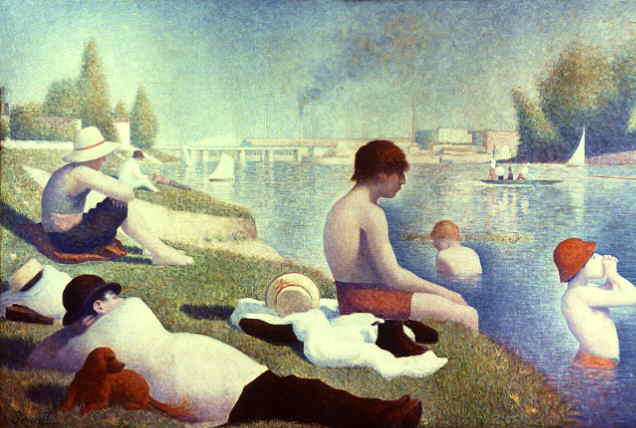
잔디가 바다에, 바다가 하늘에 모두 같은 느낌의 질감으로 다가온다. 또한, 인물과 배경이 하나로 스며들어 그것의 중요성이 구분되지 않는 새로운 스타일의 작품임을 알 수 있다. 이러한 병치 혼합은 점묘법이라고도 불리운다.
Une Baignade, Asnieres
1883-84 (retouched 1887); "Bathing at Asni?es"; 79 x 118 1/2 in; Signed, bottom left; National Gallery, LondonUne Baignade, Asnieres
Painted in the same year as Pissarro's The Pork Butcher, Seurat's first large picture shows in contrast the monumental sense of form which complemented the method (still in process of development) of dividing color. This was a move away from Impressionism though there is an Impressionist atmosphere in the landscape background with the river distance, the Courbevoie bridge and the smoking factory chimneys of the industrial Paris suburb of Asnières. In Impressionist fashion also he made a number of small oil sketches from which the final composition was derived. The sketches have the character that belongs to work carried out on the spot.
Asnières was to Seurat and his friend Signac what Argenteuil had been to Monet and Renoir. The Seine and its boats offered a like attraction; the bridge at Courbevoie and the island of the Grande Jatte, seen across the river from the bathing-place on the right, were also to furnish material for magnificent pictures. Une Baignade is a whole collection of Seurat's motifs---and a truly remarkable work for a young man of twenty-four. The kinship with Piero della Francesca that has often been remarked is distinct in the ordered rhythm of design and the firmly simplified contours. The feeling of repose is heightened by the lateral directions of figures, stylized shadows and river bank.
The picture was exhibited at the first Salon des Indépendants in 1884 and in 1886 was one of the `Works in Oil and Pastel by the Impressionists of Paris' exhibited by Durand-Ruel at the National Academy of Design in New York. Too original to find immediate favor either in Paris or New York, it received harsh criticism. The critic in an American paper who described Une Baignade as the product of `a vulgar, coarse and commonplace mind' seems with every epithet to present the exact opposite opinion to that with which the work is regarded now.
Planning the composition of Bathing at Asnieres, Seurat made field trips to the island of La Grande Jatte; the approximate site can be checked on any map of the Paris suburbs. But this first of his big canvases was executed in the studio, merely drawing upon the preliminary studies made outdoors.
Coming from Paris,
Beaubourg wrote to Coquiot, the island was on one's right, more or less opposite the spot where people swim on Sundays, halfway between the Bineau bridge and the northern tip of the island, just where the river makes a sharp bend toward Courbevoie and Asnieres. Seurat was often to be seen painting there.
Jules Christophe left this short description of Bathing at Asnieres: Water, air, the railroad bridge in the distance, boats, shimmering trees, seven men and boys in various stages of undress, either in the water or sprawled upon the grass. Not many people saw the canvas (at the Salon des Independants it was relegated to the bar), but it represented a great deal of work.
According to Signac this large composition, for which Seurat had made so many preliminary drawings and oil studies, was painted in broad, smooth brush strokes placed atop one another, in a palette of ochres and more vivid colors. Like Delacroix, he blended his colors in individual areas.
Signac goes on to sum up Seurat's method as follows: Observance of the laws of contrast, methodical separation of the elements (light, shadow, local color, reactions).
This is a hazy work, saturated with summer heat. In the distance loom factories and their smokestacks. We feel the oppressiveness of the atmosphere, the immobility of the scene. The light here weighs more heavily than the shadows. In an article, Arsene Alexandre refers to the enormous amount of work that went into this painting: Bathing at Asnieres made it clear that Seurat was the one younger artist capable of putting his back into it-one of the few capable of organizing a vast composition utilizing hitherto unknown techniques.
The many partial studies that went to produce this work have been brought together into a coherent, unified whole. The summer silence is broken only by the boy who is cupping his hands to make a sound like a boat horn. This is vacation time, rest after toil. The distribution of blacks and whites, light tones and dark, strait and curving lines (the latter predominating) is very elaborate. The light, the sun, the greenery, the buildings, the water, the people, the boats gliding along in the background- everything gives off the torpid heat of a summer afternoon.
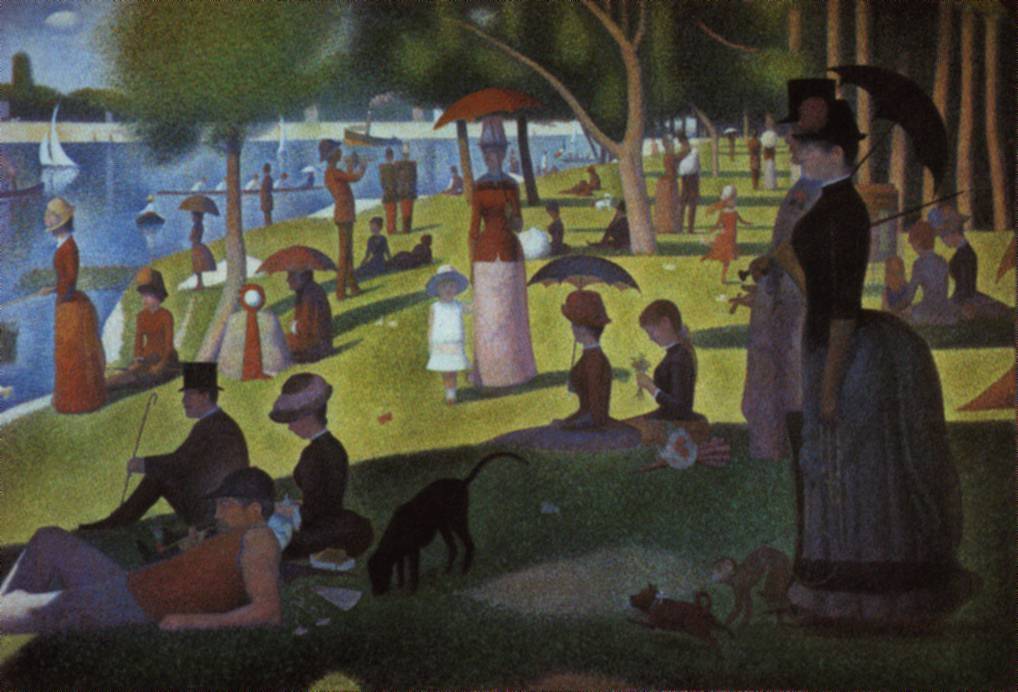
1884-86; "Sunday Afternoon on the Island of La Grande Jatte"; Oil on canvas, 81 x 120 in; Signed, bottom right; Art Institute of Chicago, Helen Birch Bartlett Collection
The question has been asked whether Seurat's great work should be regarded as the necessary outcome of Impressionist ideas or as deliberately anti-Impressionist, and an answer might be that it contains elements of both. In pursuing the analysis of colour, Seurat carried on, though in more systematic fashion, what Monet and Pissarro had been doing. The division of colour was scarcely new, though the primary colours were more scientifically defined by the range he based on the spectrum; but he added to this divisionism or pointillism an equally elaborate and scientifically considered treatment of line in order to attain a harmonious unity of composition, which was distinct from the Impressionist aim of suggesting light, atmosphere and movement.
The difference is more readily perceptible in a figure composition as here than in landscape. The men, women and children enjoying the sun in the public park on the island of La Grande Jatte in the Seine have the sort of fixity that a moving film acquires when it comes suddenly to a halt; they are frozen in their various attitudes. As a preliminary, Seurat made a number of oil sketches on the spot in a free and indeed Impressionist style. The finished work was intentionally different. The technique used is so interesting that it is apt to gain exclusive attention. One becomes absorbed in the geometric order that Seurat has imposed on the scene and this certainly is an opposite value to that of Impressionism. Pissarro, Signac and other artists attracted by the pointilliste method were somewhat led astray by the assumption that it opened up a new prospect solely in terms of translating light into colour. The comparison that has often been made between the Italian master of the geometrically-conceived composition, Piero della Francesca, and the Seurat of La Grande Jatte is justified in demonstrating the latter's essential direction. Absorbed though he was with theory, it would be wrong to assess Seurat as one unaware of the life around him. The statuesque figures to the right are the acme of bourgeois propriety though the lady may show pretensions to the eccentricity of `high life' by having a pet monkey on a lead. In many details it is a reality magically become unreal. A moment of charm is made lasting in the little girl running and the nearer girl bending over her bunch of flowers. The racing four that flashed across the canvases of Monet and Renoir at Argenteuil and other river craft here have the sharpness of a miniature.
To comment on this vast canvas where Seurat for the first time succeeded in applying, with scientific rigor, the theory of optical mixture by the division of tones-a technique which Rubens, Watteau, and Delacroix had employed intuitively-one cannot do better than to quote the following text by Jules Christophe. It was published in Les Hommes d'aujourd'hui, No. 368, an issue devoted to Seurat. The list of motives was dictated and revised by the artist himself:
Under a blazing midafternoon summer sky, we see the Seine flooded with sunshine, smart town houses on the opposite bank, and small steamboats, sailboats, and a skiff moving up and down the river. Under the trees closer to us many people are strolling, others are sitting or stretched out lazily on the bluish grass. A few are fishing. There are young ladies, a nursemaid, a Dantesque old grandmother under a parasol, a sprawled-out boatman smoking his pipe, the lower part of his trousers completely devoured by the implacable sunlight. A dark-colored dog of no particular breed is sniffing around, a rust-colored butterfly hovers in mid-air, a young mother is strolling with her little girl dressed in white with a salmon-colored sash, two budding young Army officers from Saint-Cyr are walking by the water. Of the young ladies, one of them is making a bouquet, another is a girl with red hair in a blue dress. We see a married couple carrying a baby, and, at the extreme right, appears a scandalously hieratic-looking couple, a young dandy with a rather excessively elegant lady on his arm who has a yellow, purple, and ultramarine monkey on a leash.
There was public resistance to the picture at first, Arsene Alexandre tells us: Everything was so new in this immense painting-the conception was bold and the technique one that nobody had never seen or heard before. This was the famous pointillism.
When exhibited at the Independants, the work aroused sneers and indignation. There were outcries,
Christophe goes on to say, but by standing its ground the picture's revolutionary character won out in the end. Its success was immediately hailed in La Vogue, to which Felix Feneon contributed a lively, logical, and well-informed article.
Prior to its acquisition by the Art Institute of Chicago, the painting was owned successively by Seurat's mother, Maximillien Luce, Edmond Cousturier, and Charles Vildrac.Un dimanche après-midi à l'Ile de la Grande Jatte
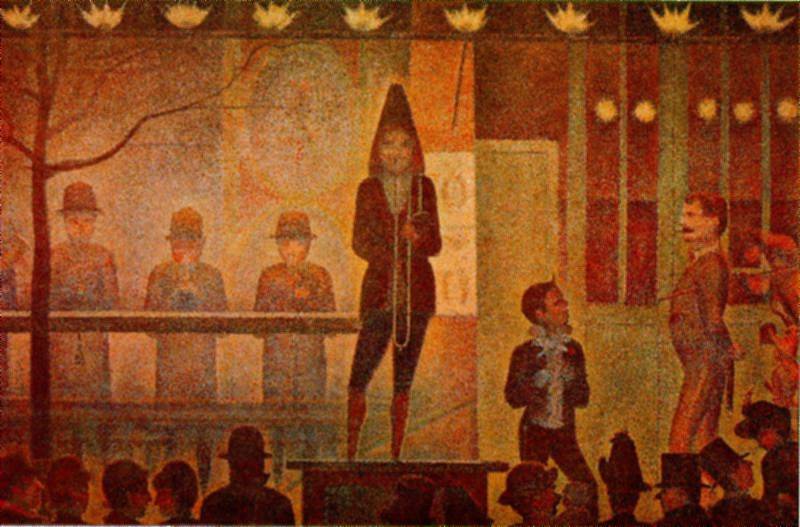
1888; Oil on Canvas, 39 3/4 x 59 1/8 in; Unsigned; The Metropolitan Museum of Art, New York. Bequest of Stephen C. Clark, 1960
After the outdoor light of La Grande Jatte and the studio light of The Models, here is an artificial light; the gas and acetylene lamps create the mood of traveling fairs.
This work shows to what extent Seurat was concerned with construction. It is clear here how deeply Seurat had been impressed by David Sutter's observations on the architectonics of classical works of art. The canvas analyzes itself, as it were. It would be pedantic nowadays to trace the counterpoint of verticals and horizontals, clear-cut rectangles and blurred ovals, the whole broken by a few slanting lines (the branches of the tree, the ringmaster's riding crop, the railing of the staircase behind the trombone player at the center).
This is perhaps the sole work of nineteenth-century painting that unequivocally anticipates Cubism (and even Purism). It heralds the coming of a new school, which, from 1908 on, was to revolutionize form no less profoundly than Seurat revolutionized the treatment of color.
Seurat here is at his coldest and most austere. It would seem that the balance of La Grande Jatte and The Models has given way to excessive deliberateness. We may say that like certain works of Poussin, The Side Show is a painting which has been wholly thought out in advance.
The face of the ringmaster (or perhaps animal trainer), with the same haircut and mustache twisted to turn up, will reappear in Le Chahut, where the riding crop is replaced by the conductor's baton.
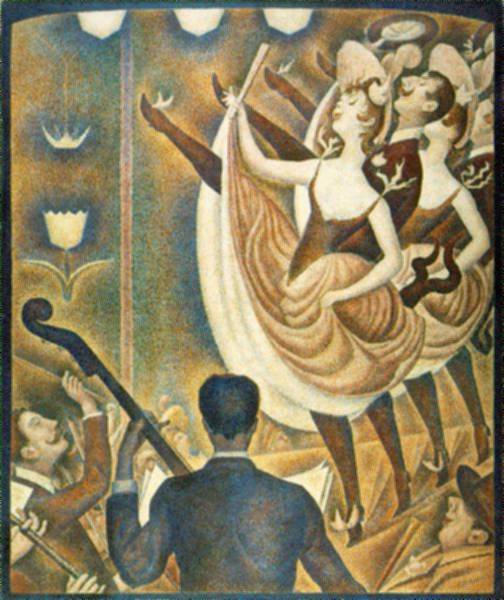
Le chahut
1889-90; Oil on Canvas, 66 1/8 x 55 1/2 in; Kroller-Muller Museum, Otterlo
A frenzied gesticulation suddenly invades Seurat's art in the final two years of his life. Seurat studied and collected Jules Cheret's posters, and their compositional form is felt in Le Chahut. The curled mustache repeated in the dancer's turned-up lips, the decorations and ribbons on the dancers' shoulders and shoes, the strange similarity of male and female legs, everything here expresses the taste for peculiar detail.
This exuberance, however, does not conceal the extreme rigor of the composition. Seurat inscribes his network of diagonals on a regular geometrical background. A figure in the foreground stabilizes the composition, as one does in The Circus. Between background and foreground breaks occur. Seurat arranges in the intermediary space of Le Chahut a series of arc-shaped curves created by the dancers legs. ``Monsieur Seurat'' wrote Felix Feneon in 1889, ``knows very well that a line, independent of its representational role, has an appraisable abstract value.''
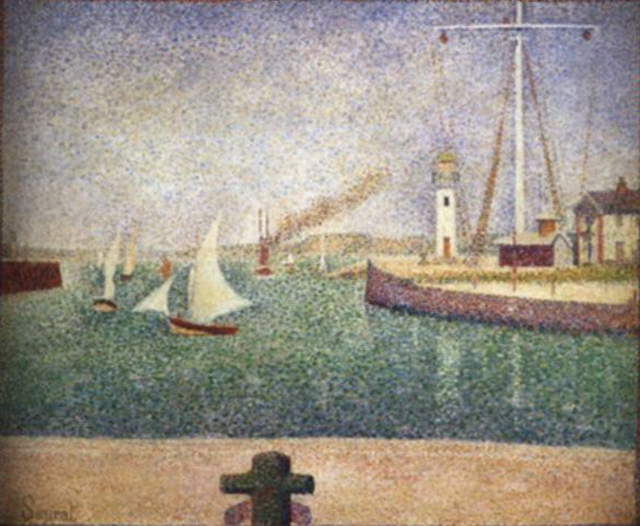
Painted 1886; "Entrance to the Port of Honfleur"; Oil on canvas, 54 x 65 cm (21 1/4 x 25 5/8 in); Signed, bottom left; The Barnes Foundation, Merion, PA.
After attracting both acclaim and scandal by exhibiting La Grande Jatte at the eighth and last impressionist exhibition, in May 1886, Seurat, the young newcomer to the Parisian avant-garde, left to work at a Channel port, as he did every summer during his brief career. That year he chose Honfleur, so often depicted by painters before and after him.
This busy port was also an elegant holiday resort. Seurat consistently chose to paint its somewhat desolate and deserted areas rather than its more picturesque sites. The scene is virtually uninhabited. Sailboats appear immobilized by an eternal calm, and the steamboat La Maria, coming from Folkestone at full steam in the center of the painting, seems as if it will never arrive. While the almost powdery technique of minute dots stills all movement, it also admirably transcribes the soft and lustrous northern light.
The seascapes painted by Seurat at Honfleur share a common peculiarity: in the foreground, a contrapuntal motif generally occurs-seemingly arbitrary, even ingenuous, in its compositional placement-at once realistic and foreign to the almost dreamlike setting. Here, a cruciform mooring post seems to threaten the entire scene. Elsewhere, it might be a sailboat's encroaching stem, anchors, or another, even more pivotal mooring post. The powerful, solitary presence of these signs further accentuates an impression of melancholy, transparency, and immateriality, qualities that compose that peculiar spell of seascapes by Seurat.
(b. Dec. 2, 1859, Paris--d. March 29, 1891, Paris)
Painter, founder of the 19th-century French school of Neo-Impressionism whose technique for portraying the play of light using tiny brushstrokes of contrasting colours became known as Pointillism. Using this techique, he created huge compositions with tiny, detached strokes of pure colour too small to be distinguished when looking at the entire work but making his paintings shimmer with brilliance. Works in this style include Une Baignade (1883-84) and Un dimanche après-midi à l'Ile de la Grande Jatte (1884-86).
A French painter who was a leader in the neo-impressionist movement of the late 19th century, Georges Seurat is the ultimate example of the artist as scientist. He spent his life studying color theories and the effects of different linear structures. His 500 drawings alone establish Seurat as a great master, but he will be remembered for his technique called pointillism, or divisionism, which uses small dots or strokes of contrasting color to create subtle changes in form.
Georges-Pierre Seurat was born on Dec. 2, 1859, in Paris. He studied at the Ecole des Beaux-Arts in 1878 and 1879. His teacher was a disciple of Jean-Auguste-Dominique Ingres. Young Seurat was strongly influenced by Rembrandt and Francisco de Goya.
After a year of military service at Brest, Seurat exhibited his drawing Aman-Jean at the official Salon in 1883. Panels from his painting Bathing at Asnieres were refused by the Salon the next year, so Seurat and several other artists founded the Societe des Artistes Independants. His famous canvas Sunday Afternoon on the Island of the Grande Jatte was the centerpiece of an exhibition in 1886. By then Seurat was spending his winters in Paris, drawing and producing one large painting each year, and his summers on France's northern coast. In his short life Seurat produced seven monumental paintings, 60 smaller ones, drawings, and sketchbooks. He kept his private life very secret, and not until his sudden death in Paris on March 29, 1891, did his friends learn of his mistress, who was the model for his painting Young Woman Holding a Powder Puff.
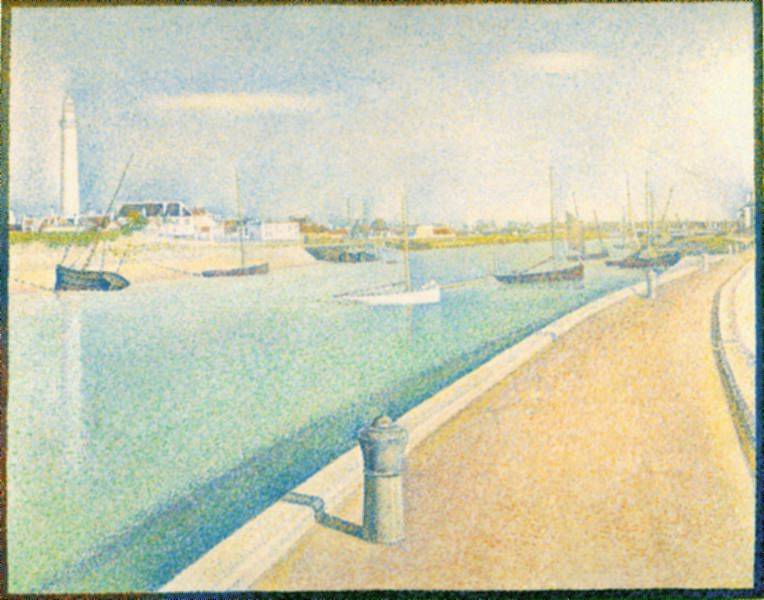
1890; Oil on canvas. 28 3/4 x 36 1/2 in; Signed, bottom right; The Indianapolis Museum of Art. Gift in memory of Daniel W. and Elizabeth C. Marmon
This is a canvas that presents in one compact vision the air of the harbor and of the sea. An impression of stability is supplied by the bollards along the sea wall casting their shadows in the direction of the channel. The rest is infinity, the infinity of a perspective in an elegant parabola, seemingly a prelude to the immensity of the sea, here perfectly calm and inducing to calm. The free, full, modulated space which cuts the painting in two gives off utter serenity: the lighthouse, the boats at anchor, and the harbor cut across by one sweeping diagonal to provide the contrasting movement.
This painting is luminous, flooded with light and sunshine, rather high in color; it contrasts with the evening effect of the channel scene in the William A. M. Burden collection. As Lucie Cousturier observed of Seurat, ``he could sit in front of any bench, tree, or wall which others had previously depicted, and his own vision would not be influenced one particle.''
The canvas was exhibited at the Exposition des XX in Brussels, and at the Independants of 1891 with The Circus. There exists one study for it on a panel which was owned by Maximillien Luce.
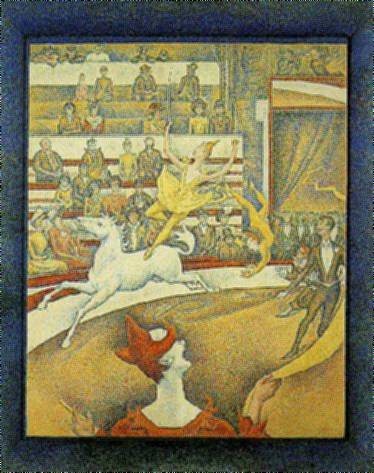
1891; Oil on canvas, 73 x 59 1/8 in; unsigned; Musee d'Orsay, Paris
This is beyond any question the most baroque work Seurat ever painted. The unfinished canvas is composed of circles, spirals, and ellipses. Exceptionally, it is built up on horizontals with the entrance to the ring at the right the only vertical break.
Seurat was fond of novels by the Goncourt brothers, and here gives us a visual counterpart to the Freres Zemgano , a tale about the circus. Lucie Cousturier wrote that the composition ``sets itself the aim of holding within one sweeping curve all the upward-running lines denoting circus fun and games.'' The movement from right to left, that of the lady bareback rider who, ``a modern goddess of grace and freedom,'' is doing acrobatics on the white horse, is counterpoised by the movement of the clown in the center with the garish wig, who arises perpendicularly from the foreground.
The figure in the first row of seats, with a silk hat and a peak of hair visible under it, is the painter Charles Angrand, a friend of Seurat's.
This work was exhibited in its unfinished state at the seventh Salon des Independants, from March 20 to April 27, 1891. Seurat died during the exhibition.
The Circus is almost a plagiarism. Robert L. Herbert-who has pointed out similarities between certain of Cheret's posters and Seurat's compositions-proves that the clown is identical (only reversed) with one in a poster by Cheret of 1880, executed for the Spectacle-Promenade de l'Horloge in the Champs-Elysees. (Cheret also was acquainted with the works of Rood and Chevreul.) As for the over-all design, Meyer Schapiro has proved that Seurat took it from an anonymous poster for the Nouveau Cirque, printed in 1888, reversing the horse and the bareback rider. But the drawing in that poster bears no comparison with Seurat's painting-it is heavy, clumsy, the horse moves sluggishly, the rider is ungraceful-whereas in Seurat everything gallops and cavorts.
The layout of this painting almost seems to have been done by some mechanical process, a tracing in blue. That we can even think this is no doubt accounted for by its unfinished state, as Feneon suggested in a letter where he gave it as his opinion that The Circus is finished only ``so far as the background is concerned (rows of spectators merely indicated in blue).''
Seurat painted the flat frame for the painting, and it bears his signiture. Signac, who was able to purchase the picture quite cheaply, noted in his diary: ``Seurat's family, though very well off, is selling everything.''
pissaro
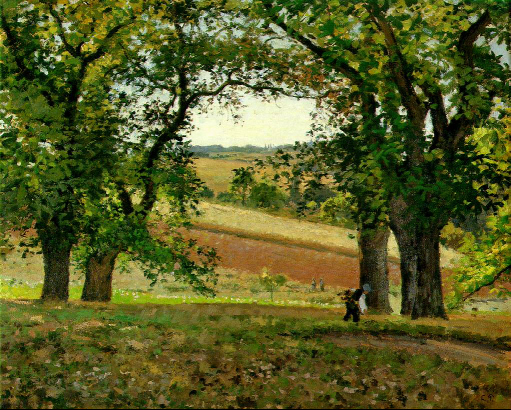
The Chestnut Trees at Osny Les chataigniers a Osny
c. 1873 ; Oil on canvas, 65 x 81 cm (25 5/8 x 31 7/8");
Private collection, New Jersey
*Osny의 밤나무*
정오, 울창한 숲으로 어우러진 깊은 산속에서 하늘을 향해 누워 본 적이 있다면 느낄 수 있는 나무내음과 초록빛 잎들 사이로 내리쬐는 보석같은 햇빛들.
지금 이 작품은 여름에서 마악 가을로 접어들어 8월의 한낮처럼 뜨거운 기운과 9월의 숲내음이 드러나는 어느 오후이지 않나싶다.
하늘을 가릴듯 커다란 밤나무들이 보여지며 그 가운데 밤을 줍는 아낙네의 모습에서 알 수 있듯이 관객 또한 풍요로운 수확의 기쁨을 맛볼 수 있는 풍성한 그림이다.
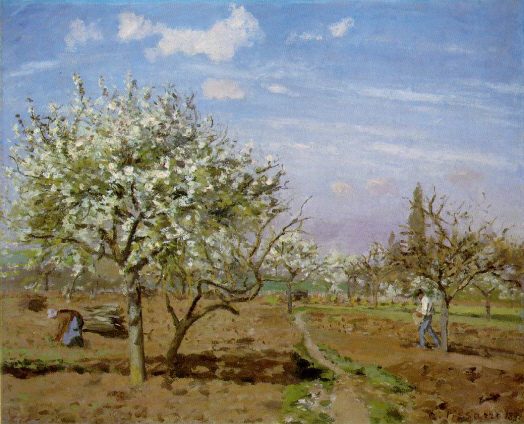
Le verger 1872 ; Oil on linen, 45.1 x 54.9 cm (17 3/4 x 21 5/8");
National Gallery of Art, Washington
*과수원*
인상주의 작가들은 빛을 쫓아 야외로 이젤을 옮겨 풍경화를 그리기 시작했다. 그리고는 시간이 흘러 빛이 사라질 쯤에 집으로 들어와 그 그림을 마무리하곤 하였다.
화창한 봄날, 한가로운 오후, 꽃이 활짝 피어있는 과실나무를 가꾸는 어느 부부의 바쁜 손놀림을
관객은 마치 버스를 타고 시골길을 지나면서 보는 풍경인 듯한 착각을 불러일으키게 된다. 그러므로 느껴지는 여유로운 상상이 그야말로 한 폭의 그림같은 작품이다.
signac
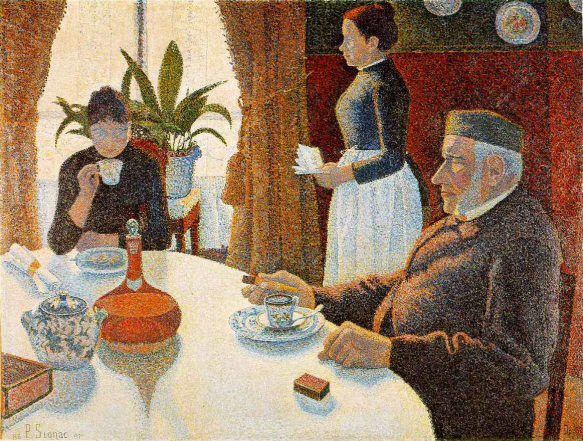
The Dining Room
Oil on white primed canvas ,89 x 115 cm (35 x 45 1/4 in)
*거실*
시냑의 작품은 신인상주의의 대표로 불리는 쇠라의 기법과 같은 분할주의 기법을 사용하였다. 시냑의 작품을 자세히 관찰해보면 그 속에서 독특한 마띠에르를 찾을 수 있다. 그리고 그 마띠에르는 마치 돌표면처럼 보이는 거친 느낌이 든다.
그 이유는 쇠라의 것이 본래의 색에 주변색을 넣어 스며드는 느낌이라면 시냑은 모든 본래의 색에 하얀색을 넣어 거친 돌표면을 연상시키지 않나 싶다.
sisly
'History of Arts > 19C' 카테고리의 다른 글
| German Expressionism (2) | 2007.12.03 |
|---|---|
| Austria Expressionism (0) | 2007.12.01 |
| Auguste Rodin (1) | 2007.11.13 |
| 19C- 상징주의 (0) | 2007.11.12 |
| Hide and Seek (0) | 2007.10.17 |
